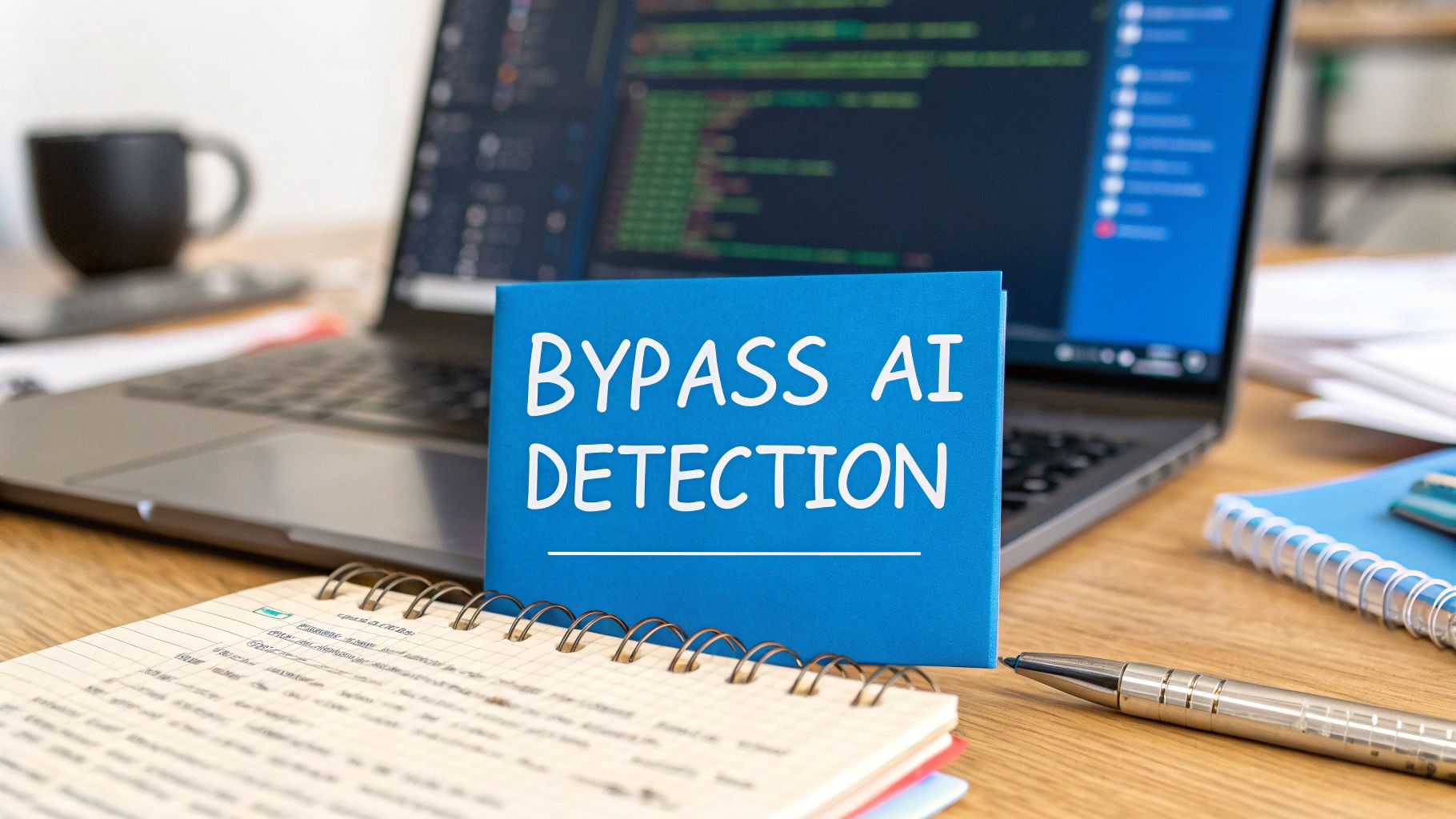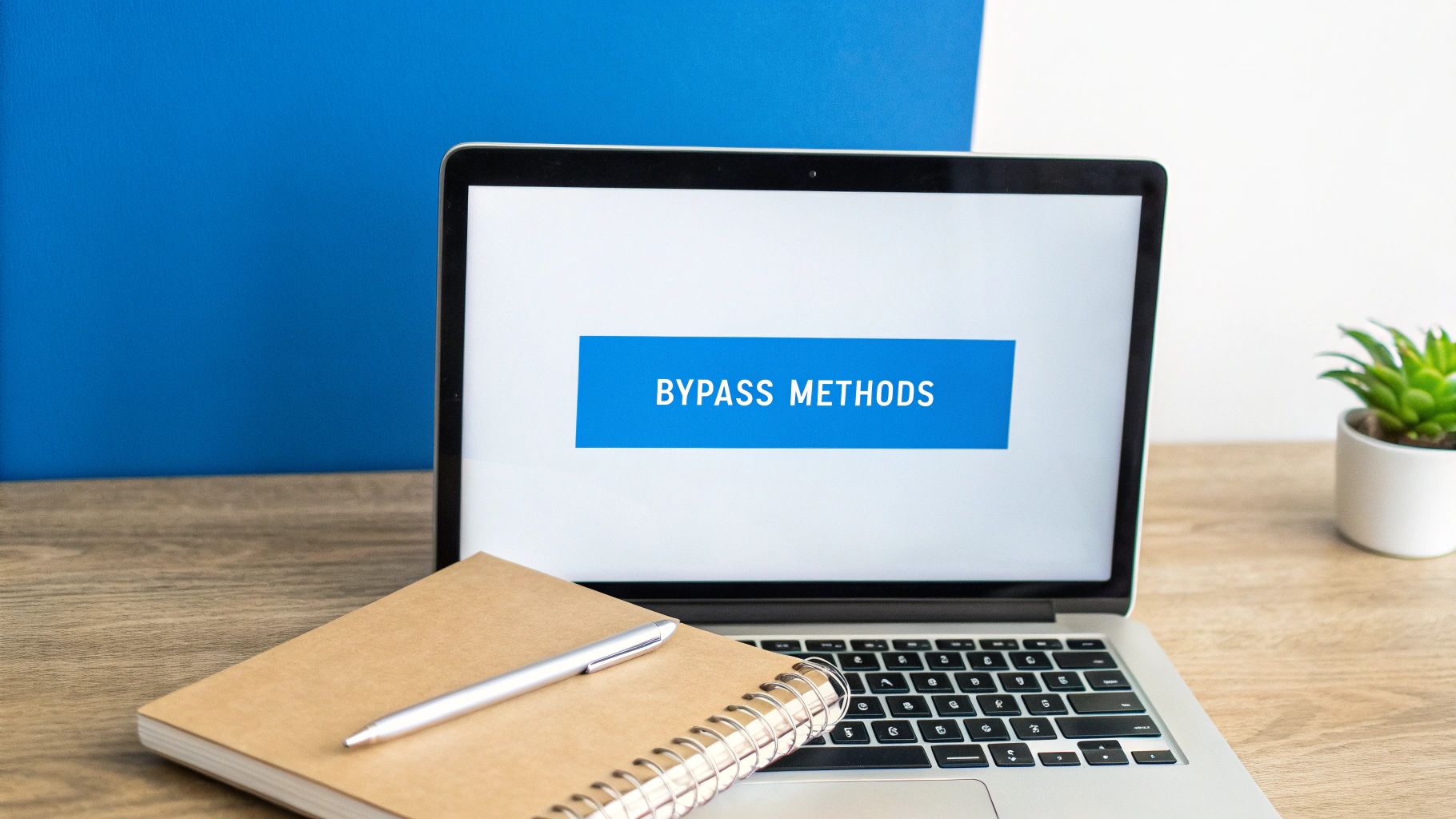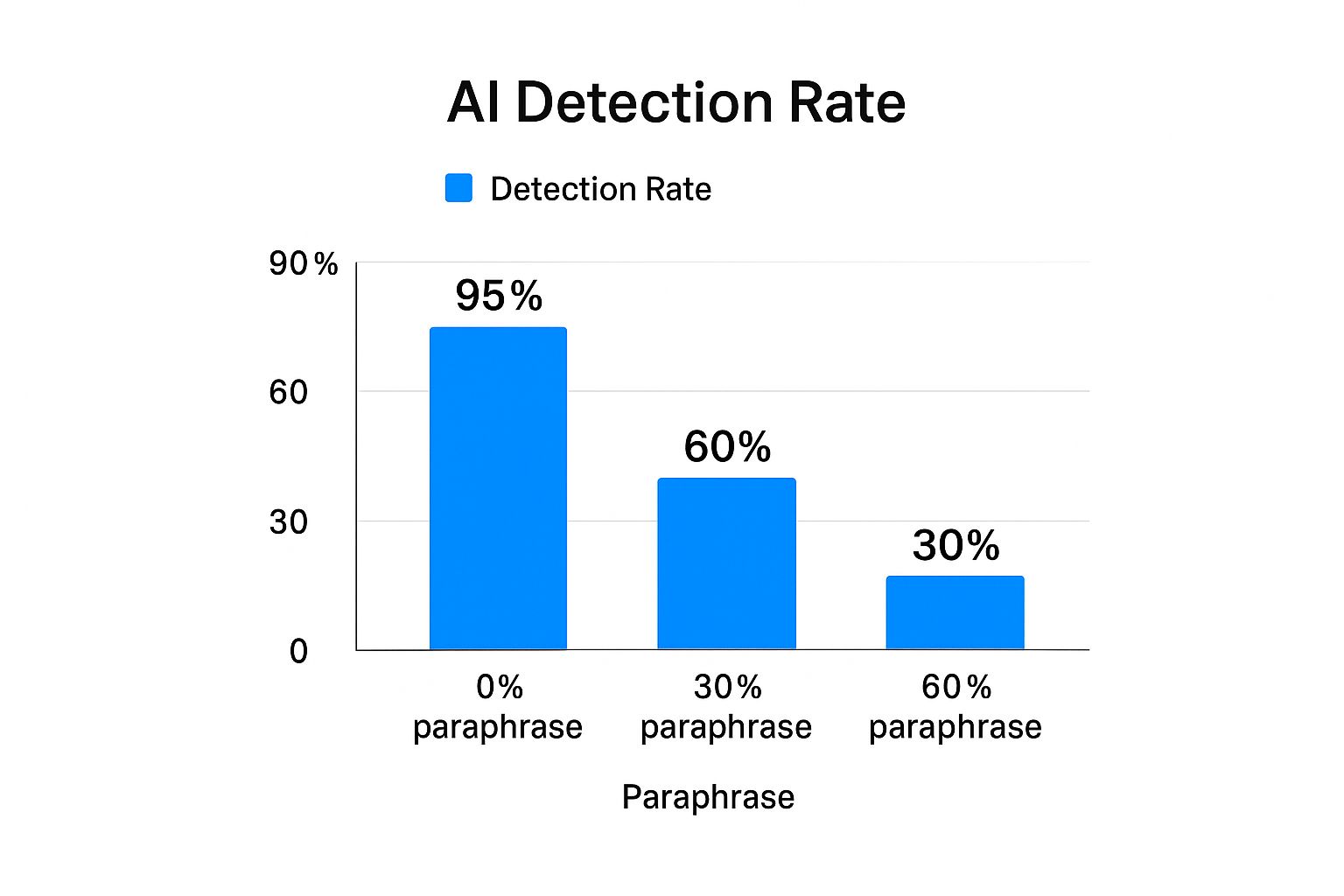How to Bypass AI Detection and Humanize Your Content

To have any shot at bypassing AI detection, you have to get your hands dirty. The most straightforward way is to manually edit AI-generated text, tweaking its structure, sentence length, and word choice. This process, which many of us call humanizing, is all about breaking the predictable patterns that AI detectors are trained to spot. The goal is to make the content feel natural and genuinely human.
How AI Detectors Actually Work
Before you can learn to sidestep these tools, you first need to understand what they're actually looking for. Think of detectors like GPTZero or Turnitin as digital bloodhounds. They aren't reading for meaning; they're sniffing out the "fingerprints" left behind by large language models by analyzing patterns in the text.
Two key concepts they lock onto are perplexity and burstiness. Perplexity is just a fancy way of measuring how predictable your text is. AI content usually has very low perplexity because it’s built to choose the most statistically likely word, which often makes the writing feel a bit bland and uniform.
Burstiness, on the other hand, is all about variety. Humans naturally write with a mix of long, winding sentences and short, punchy ones. AI often spits out sentences of a similar length and structure, creating a robotic rhythm that these detectors can pick up on from a mile away.
The Signals They Search For
AI detectors have been fed massive datasets, learning to recognize the subtle but consistent quirks of machine-generated text. To really get a grip on this, it helps to understand the various applications of AI in digital marketing, where content is often produced at a huge scale. This context explains exactly why detection tools became so necessary in the first place.
Here’s what these tools are trained to find:
- Uniform Sentence Structure: AI tends to fall back on simple, repetitive sentence formats.
- Overuse of Common Words: Language models often favor common conjunctions and transition words like "however," "therefore," or "in addition."
- Lack of a Unique Voice: The absence of personal stories, humor, or strong, clear opinions is a huge red flag for a detector.
The biggest hurdle for any AI is faking true human randomness. Even as these models get smarter, their output is still dictated by algorithms, and algorithms, by their very nature, create patterns.
Why Detectors Are Not Perfect
It’s really important to remember that these tools are far from foolproof. They can—and do—produce false positives, sometimes flagging human-written text as AI-generated, especially if the writing is very formal or follows a strict template. The question of whether AI can really be detected with 100% accuracy is still a hot topic of debate.
In 2025, bypassing AI detection is becoming more about using advanced text randomization techniques combined with domain-specific language to hide the AI's typical writing style. Understanding how these tools work is your first step toward creating content that sails right past them.
Manually Restructuring AI-Generated Content
Sometimes, the best way to make AI text undetectable is to just roll up your sleeves and edit it yourself. This is about more than a simple word swap or running it through a thesaurus. We're talking about a fundamental rework of the content's structure to get rid of that distinct, robotic signature.
The core of the problem is that AI models love predictable patterns. For instance, they tend to churn out paragraphs where every sentence follows the same old subject-verb-object formula. Your job is to break that monotony.
A fantastic starting point is sentence length. Scan the AI's output. You'll likely spot sections where every sentence is roughly the same length. Mix it up. Combine some of those short, choppy sentences into a more complex, flowing thought. Then, take the long, rambling ones and break them down into sharp, punchy statements.
Reordering Ideas for Natural Flow
Another dead giveaway of AI writing is its perfect, yet completely unnatural, flow of ideas. It lays everything out in a super-linear, step-by-step way that just isn't how real people explain things.
To fix this, start shuffling the ideas around within each paragraph. Try moving the main takeaway to the very beginning to serve as a hook. Or, you could rearrange supporting details to build a more interesting narrative. It’s all about disrupting the AI's predictable rhythm.
Let's look at a quick example. Here's a typical AI-generated sentence:
- AI Version: "The company launched a new product, which was designed to meet customer needs, and it featured several new upgrades."
It's clunky and robotic. Now, let’s rephrase it to sound more human:
- Humanized Version: "Responding directly to customer feedback, the company’s new product launch was packed with several key upgrades."
The goal isn't to start from scratch. It's about strategically deconstructing and rebuilding what the AI gave you. You keep the core message but inject a human rhythm and flow that the machine just can't replicate.
Altering Sentence Structure
One of the most effective manual edits you can make is restructuring sentences. This means rewriting AI text to change its grammatical structure without losing the original meaning. This is a critical skill for anyone learning how to bypass AI detection. The more you practice, the faster you'll get at spotting and fixing these robotic sentences.
By actively changing how sentences start, merging clauses together, and shifting the order of information, you create a text that's much harder for algorithms to flag. It’s this hands-on, thoughtful editing that truly humanizes your content.
Using AI Humanizer Tools Strategically
When you're up against a deadline, an AI humanizer can feel like a secret weapon. But their real power isn't in a single click; it's in how you use them. Think of these AI-to-human converters as a highly sophisticated first-pass editor, not a magic wand that does all the work for you.
These tools are designed to automatically introduce the kind of linguistic complexity that AI detectors are trained to spot. They vary sentence structures, swap out predictable AI phrasing, and adjust the overall rhythm to mimic human writing. In technical terms, this process lowers the "perplexity" and increases the "burstiness"—two key signals that AI detectors look for.
Beyond the First Click
The biggest mistake I see people make is treating a humanizer as the final step. To truly learn how to bypass AI detection, you need a more layered approach. Simply pasting your text, hitting "humanize," and copying the output often isn't enough to get the job done right.
Here's a pro tip from my own experience: run your text through the tool a couple of times. The first pass will likely catch the most obvious AI tells, but a second pass can refine the text even further, smoothing out any remaining robotic artifacts. You can even get creative and run the text through two different humanizers to generate a more uniquely styled result. To get a better feel for the kinds of raw material you might be working with, it's helpful to explore the best AI content creation tools available.
Treat AI humanizers as a powerful assistant, not an author. Their job is to do the heavy lifting of structural changes so you can focus on the final polish and adding your unique voice.
The most effective tools have achieved remarkably low detection rates in recent tests. In fact, some leading AI humanizers have shown bypass rates reportedly as low as 2%, meaning a tiny fraction of their output was flagged by top detectors like GPTZero or Turnitin. This data shows just how far the technology has come.
Ultimately, your strategy should always end with a final manual sweep. Read the humanized text out loud. This simple trick helps you catch awkward phrasing, fix any lingering robotic sentences, and inject your own personal touch. This final step is what ensures the content isn't just undetectable, but genuinely polished and authentic.
Adding Authentic Human Elements to Your Content
Technical fixes and AI humanizers are a great start, but if you really want to fly under the radar of AI detectors, you need to lean into what machines can't replicate. The biggest weakness of any AI is that it has no real, lived experiences. That’s your secret weapon.
When you weave in personal stories, unique opinions, and real-world insights, you create a powerful signal of authenticity. An AI can spit out facts, but it can't tell you about a project that went sideways or share a funny observation from a client call. These are the human details that build a real connection with your reader.
Develop a Distinctive Voice
Let's be honest—most AI writing defaults to a bland, formal tone. It's predictable. Developing a distinctive voice is one of the most effective ways to make your content sound genuinely human. This could mean using a bit of humor, adopting a strong perspective, or sprinkling in expressions that feel natural to you.
Here are a few ways to do it:
- Tell a Story: Instead of just listing facts, frame them in a narrative. For example, "I once spent a solid week trying to rank for a keyword, only to realize my entire strategy was flawed because…"
- Inject Niche Data: Did you run a quick poll on LinkedIn? Notice a weird trend in your own analytics? This kind of exclusive data adds a layer of credibility that an AI simply can't scrape from its training set.
- Use Your Own Words: Don't be scared to use a little slang, inside jokes your audience will get, or just conversational language.
The real goal here is to stop just providing information and start having a genuine conversation with your audience. When your personality shines through, the content is not only more engaging but also far less likely to get flagged by a machine.
Of course, beyond just avoiding detection, focusing on overall content quality is critical for both engagement and SEO. It's always a good idea to explore different content optimization strategies to make your work even better.
Ultimately, these human touches do more than just help you with how to bypass ai detection; they make your content memorable and truly valuable. For a deeper dive into this process, our guide on how to humanize AI text has even more actionable tips.
Choosing Your AI Detection Evasion Method
Let's be clear: there’s no magic bullet for bypassing AI detection. The best approach for you is going to depend entirely on your specific situation. What works for a student scrambling to meet a deadline won't be the right fit for a blogger playing the long game with SEO or a marketer who needs to pump out quality content at scale.
To pick the right strategy, you have to get real about your goals, timeline, and resources. It's a balancing act between the effort you're willing to put in, potential costs, how fast you need to move, and the level of effectiveness you're aiming for.
This image really drives the point home, showing how even a moderate amount of paraphrasing can dramatically lower the chances of your content getting flagged by an AI detector.
The data doesn't lie. The more you tweak and transform the original AI text, the safer you are. This is exactly why a good manual edit or a quality humanizer tool is so valuable.
Effectiveness of AI Detection Bypass Methods
To help you decide which path to take, I've put together a quick comparison of the most common techniques. Think of this as your cheat sheet for matching the right method to your needs.
| Method | Effort Level | Typical Cost | Effectiveness | Best For |
|---|---|---|---|---|
| Manual Editing | High | Free (but time-intensive) | Very High | Polishing crucial content and ensuring a perfect, personal voice. |
| AI Humanizer | Low | Low-cost subscription | High | Quickly processing large volumes of text while maintaining quality. |
| Adding Insights | Medium | Free (requires expertise) | Very High | Establishing authority and making content uniquely valuable to readers. |
As you can see, each method has its own trade-offs. The right choice hinges on what you value most—speed, cost, or a completely custom feel.
The smartest play? Often, it's a mix of these strategies. I frequently use an AI humanizer to do the initial heavy lifting, then I'll jump in to sprinkle in my own personal stories and give it a final manual polish. This hybrid approach gives you the best of both worlds.
If you're looking for more inspiration, you can explore other bypass AI detection strategies to find the perfect recipe for your workflow. Ultimately, the goal is to find a process that consistently delivers authentic, high-quality results without bogging you down.
Got Questions? We've Got Answers
When you start working with AI content, a lot of questions pop up. It's totally normal. Getting straight answers is the key to using these tools the right way, especially when you're trying to figure out how to make AI text sound human without getting into hot water.
Is It Illegal or Unethical to Bypass AI Detection?
This is the big one, and honestly, the answer is a bit of a gray area. Let's be clear: it is not illegal to humanize text that started as an AI draft.
The ethics, though? That all comes down to why you're doing it. If you're a student trying to pass off AI work as your own, you're likely breaking your school's academic integrity rules. For professionals and content creators, the game is different. The focus should be on being transparent and, most importantly, adding real, human value to the content.
The real principle here is to avoid deceiving your audience. The goal isn't just to trick a detector. It's to produce high-quality, authentic content you're proud of, regardless of whether it began with an AI prompt or a blank page.
Can Any Tool Guarantee Undetectable AI Content?
Nope. And any tool that promises a 100% guarantee isn't being straight with you. The technology behind AI detectors is getting smarter all the time, right alongside the AI writing models themselves. It's a constant cat-and-mouse game.
Your best bet is a blended approach.
Think of an AI humanizer as your first pass—it does the heavy lifting of restructuring sentences and swapping out robotic phrasing. But the final, critical step is always a manual review. This is where you inject your own voice, add personal stories, fix any clunky sentences, and make sure it flows naturally.
We break this combined process down even further in our guide on how to avoid AI detection in writing.
Will Humanizing AI Content Hurt My SEO?
Actually, it's just the opposite. Humanizing your AI content will almost always give your SEO a boost.
Search engines like Google have been very direct about what they want: helpful, reliable, people-first content. The very act of humanizing—making text more readable, adding unique insights, and checking facts—is exactly what good SEO is all about. It helps your content rank higher and, more importantly, builds trust with the people reading it.
Ready to create authentic, human-like content that sails past AI detectors? With Word Spinner, you can humanize, rewrite, and generate high-quality text in minutes. Try our all-in-one writing platform for free and see the difference. Start your free trial at Word Spinner today



